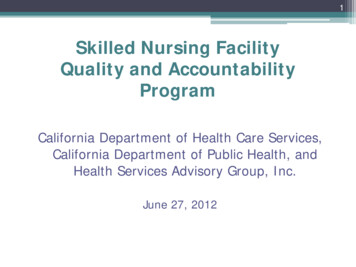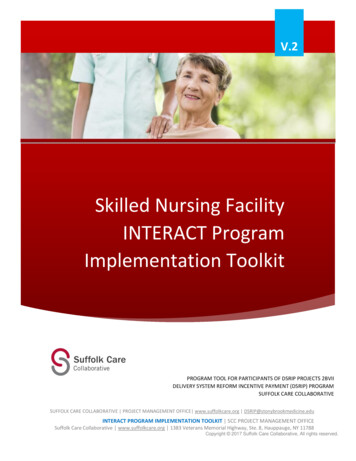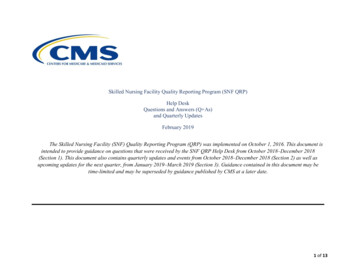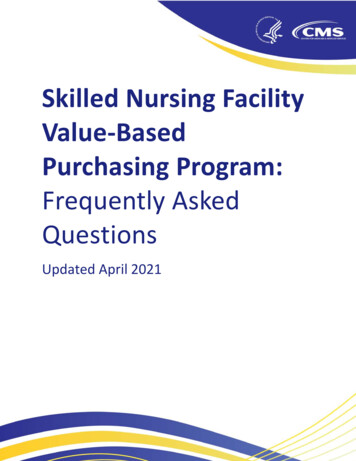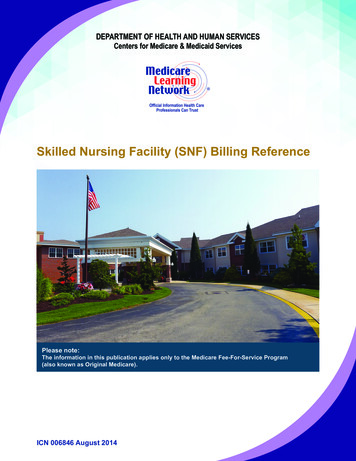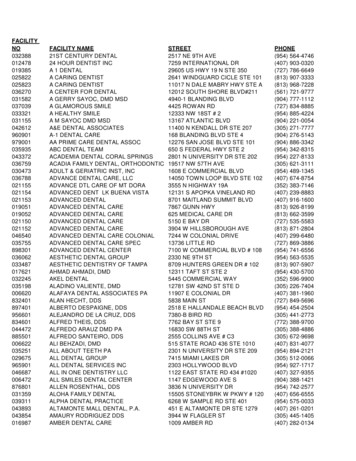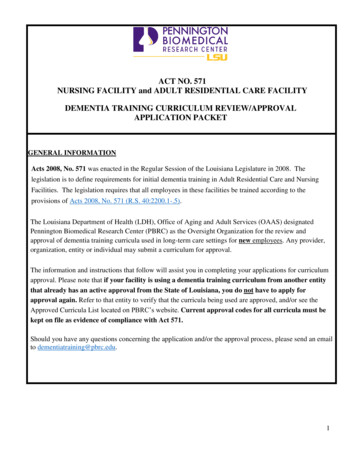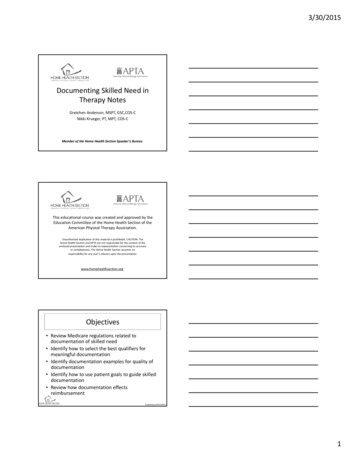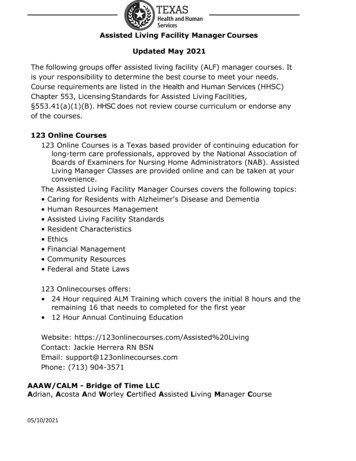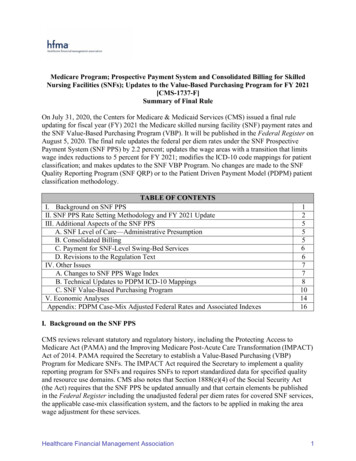
Transcription
Medicare Program; Prospective Payment System and Consolidated Billing for SkilledNursing Facilities (SNFs); Updates to the Value-Based Purchasing Program for FY 2021[CMS-1737-F]Summary of Final RuleOn July 31, 2020, the Centers for Medicare & Medicaid Services (CMS) issued a final ruleupdating for fiscal year (FY) 2021 the Medicare skilled nursing facility (SNF) payment rates andthe SNF Value-Based Purchasing Program (VBP). It will be published in the Federal Register onAugust 5, 2020. The final rule updates the federal per diem rates under the SNF ProspectivePayment System (SNF PPS) by 2.2 percent; updates the wage areas with a transition that limitswage index reductions to 5 percent for FY 2021; modifies the ICD-10 code mappings for patientclassification; and makes updates to the SNF VBP Program. No changes are made to the SNFQuality Reporting Program (SNF QRP) or to the Patient Driven Payment Model (PDPM) patientclassification methodology.TABLE OF CONTENTSI. Background on SNF PPSII. SNF PPS Rate Setting Methodology and FY 2021 UpdateIII. Additional Aspects of the SNF PPSA. SNF Level of Care—Administrative PresumptionB. Consolidated BillingC. Payment for SNF-Level Swing-Bed ServicesD. Revisions to the Regulation TextIV. Other IssuesA. Changes to SNF PPS Wage IndexB. Technical Updates to PDPM ICD-10 MappingsC. SNF Value-Based Purchasing ProgramV. Economic AnalysesAppendix: PDPM Case-Mix Adjusted Federal Rates and Associated Indexes1255566778101416I. Background on the SNF PPSCMS reviews relevant statutory and regulatory history, including the Protecting Access toMedicare Act (PAMA) and the Improving Medicare Post-Acute Care Transformation (IMPACT)Act of 2014. PAMA required the Secretary to establish a Value-Based Purchasing (VBP)Program for Medicare SNFs. The IMPACT Act required the Secretary to implement a qualityreporting program for SNFs and requires SNFs to report standardized data for specified qualityand resource use domains. CMS also notes that Section 1888(e)(4) of the Social Security Act(the Act) requires that the SNF PPS be updated annually and that certain elements be publishedin the Federal Register including the unadjusted federal per diem rates for covered SNF services,the applicable case-mix classification system, and the factors to be applied in making the areawage adjustment for these services.Healthcare Financial Management Association1
Beginning in FY 2020, CMS implemented a new case-mix classification system to classify SNFpatients under the SNF PPS, the PDPM (83 FR 39162). While the previous RUG-IVclassification model primarily used the volume of therapy services provided to the patient as thebasis for payment, PDPM classifies patients into payment groups based on specific, data-drivenpatient characteristics. CMS notes that it continues to monitor the impact of PDPMimplementation on patient outcomes and program outlays. It hopes to release information onthese issues in the future when more data are available.In the proposed rule, CMS invited stakeholders to comment on any observations or informationrelated to the impact of PDPM implementation on providers or on patient care. CMS does notindicate receipt of any such comments.II. SNF PPS Rate Setting Methodology and FY 2021 UpdateA summary of key data for the SNF PPS for FY 2021 is presented below with additional detailsprovided in the subsequent sections.Summary of Key Data under SNF PPS for FY 2021Market basket update factorMarket basket increase 2.2%Forecast error adjustment for FY 20180.0%Required multifactor productivity (MFP) adjustment0.0%Net MFP-adjusted update 2.2%Wage index budget neutrality adjustment0.9992Labor-related share71.3%Final FY 2021 Unadjusted Federal Rates Per DiemRate component – PDPMUrbanRuralPhysical Therapy 62.04 70.72Occupational Therapy 57.75 64.95Speech-Language Pathology 23.16 29.18Nursing 108.16 103.34Non-Therapy Ancillaries 81.60 77.96Non-case mix adjusted 96.85 98.64A. Federal Base RatesCMS reviews the historical process used for setting the initial federal base rates, which wereestablished for implementation of the SNF PPS beginning July 1, 1998. These rates have beenupdated for inflation and other factors through subsequent rulemaking and statutoryrequirements.B. SNF Market Basket UpdateCMS finalizes a market basket increase for FY 2021 of 2.2 percent based on the second quarter2020 forecast from IHS Global Insight, Inc.(IGI), with historical data through the first quarter ofHealthcare Financial Management Association2
2020. The forecast addresses the percentage increase in the FY 2014-based SNF market basketindex for routine, ancillary, and capital-related expenses.The 2.2 percent final market basket forecast is substantially below the 2.7 percent included in theproposed rule, which was based on IGI’s first quarter 2020 forecast, with historical data throughfourth quarter 2019. CMS notes the lower forecast is primarily the result of slower growth incompensation for both health-related and other occupations, as labor markets are expected to besignificantly impacted by the recession that began in February 2020.No adjustment to the market basket update is made to account for forecast errors in previousmarket basket estimates. The most recent year for which actual data are available is FY 2019.The forecast FY 2019 market basket increase was 2.75 percent and the actual increase was 2.34percent. The difference between the estimated and actual amount of change in the market basketindex was 0.41 percent and does not exceed the previously adopted 0.5 percentage pointthreshold for making the adjustment. Moreover, CMS states that it would be inappropriate toapply a forecast error adjustment because the FY 2019 market basket update of 2.4 percent wasset by statute (section 53111 of the Bipartisan Budget Act of 2018 (Pub. L. 115–123)).The final multifactor productivity (MFP) adjustment is 0.0, a notable change from the proposedrule, which included an adjustment of -0.4 percentage points. For the final rule, CMS uses themost recent available forecast for the 10-year moving average of changes in MFP for the periodending September 30, 2021. That forecast, from June 2020, is -0.1, which if subtracted from themarket basket would result in a 0.1 percentage point addition to the SNF update factor. Thestatute does not allow for a positive MFP adjustment; therefore the final rule includes anadjustment of 0.0 percentage points. CMS notes that it is not using IGI’s second quarter 2020MFP forecast, which is usually would do for the final rule MFP as well as for the market basketforecast. That forecast would have resulted in an MFP adjustment for FY 2021 of -0.7percentage points. The large difference in the second quarter and June MFP forecasts is atypicaland due to the unprecedented economic uncertainty associated with the COVID-19 pandemic.(The MFP forecasts are available monthly, whereas the market basket forecast is only updatedquarterly. The most recent market basket forecast available for the final rule is the second quarter2020 forecast.)Taking these elements together, the resulting final SNF market basket update equals 2.2 percent.CMS also applies a 2.0 percentage point reduction to the SNF market basket percentage changesfor SNFs that do not satisfy the reporting requirements for the FY 2021 SNF QRP. CMSexplains that this is derived by subtracting 2.0 percentage points from the MFP-adjusted marketbasket update of 2.2 percent resulting in a positive 0.2 percentage point update for FY 2021.Using the final MFP-adjusted update, CMS finalizes FY 2021 unadjusted federal rates for eachcomponent of the payment for urban and rural areas. Tables 3 and 4 in the final rule, summarizedin the table above, present the per diem rates for FY 2021. Under the PDPM case-mixclassification system, the unadjusted federal per diem rates are divided into six components. Fiveof these are case-mix adjusted components: Physical Therapy (PT), Occupational Therapy (OT),Speech-Language Pathology (SLP), Nursing, and Non-Therapy Ancillaries (NTA). Theremaining component is a non-case-mix component, as existed under the previous RUG-IVHealthcare Financial Management Association3
classification system. CMS further notes that elsewhere in final rule it adopts changes to thedelineation of urban and rural areas for FY 2021. (See section IV.A of this summary.)C. Case-Mix AdjustmentAs noted earlier, CMS replaced its previous case-mix classification methodology, the RUG-IVmodel, with the PDPM effective October 1, 2019. The PDPM model was designed to classifypatients into payment groups based on patient characteristics, rather than the volume of therapyservices provided to patients, as done in the RUG-IV model. The FY 2021 payment rates reflectthe use of the PDPM classification system from October 1, 2020 through September 30, 2021.CMS lists the final case-mix adjusted PDPM payment rates for FY 2021, for urban and ruralSNFs, in Tables 5 and 6 of the final rule (reproduced in an appendix to this summary); whichreflects updated calculations from the proposed rule.CMS notes that in future rulemaking it may reconsider the adjustments it made in the FY 2020SNF PPS final rule to the case-mix weights used under PDPM to ensure budget neutrality in theimplementation of the PDPM, and recalibrate these adjustments as appropriate.D. Wage-Index AdjustmentThe final rule continues application of the wage index adjustment to the labor-related portion ofthe federal rate using the pre-reclassified IPPS hospital wage data, without applying theoccupational mix, the rural floor, or outmigration adjustments, as the basis for the SNF PPSwage index. For FY 2021, CMS uses updated wage data for hospital cost reporting periods in FY2017. Responding to comments suggesting that SNF wage data be used instead, CMS notes thatto use wage data from SNF cost reports would require audits that would burden SNFs andrequire a commitment of resources from CMS and the Medicare Administrative Contractors thatis not feasible at this time.Elsewhere in this final rule, CMS adopts revisions to the Office of Management and Budget(OMB) area delineations for purposes of the FY 2021 SNF wage index, and will apply a 5percent cap on any decrease in a hospital’s wage index for FY 2021 compared with its FY 2020wage index. The wage index budget neutrality adjustment applies. (See section IV.A of thissummary.)CMS notes that that wage index tables are available exclusively through the CMS website, vice-Payment/SNFPPS/WageIndex.html.The final rule table shows, by county, the FY 2020 and FY 2021 wage area assignment as well asthe FY 2021 wage index, including the application of the proposed 5 percent cap on decreasedwage index values. The wage index adjustment is applied to the labor-related share. CMS uses afour-step process to trend forward the base year (2014) weights to FY 2021 price levels. Thisprocess includes computing the FY 2021 price index level for the total market basket and eachcost category of the market basket. Based on this update, the final FY 2021 SNF labor-relatedshare is 71.3 percent, compared with to a FY 2020 final labor-related share of 70.9 percent.Table 7 in the final rule summarizes the labor-related share for FY 2021 (based on the IGIHealthcare Financial Management Association4
second quarter 2020 forecast) compared with FY 2020 for each of the cost categories.In order to calculate the labor portion of the case-mix adjusted per diem rate, one would multiplythe total case-mix adjusted per diem rate, which is the sum of all five case-mix adjustedcomponents into which a patient classifies, and the non-case mix component rate, by the FY2021 labor-related share percentage. CMS notes that in prior years, it has provided the labor andnon-labor related shares of case-mix adjusted payments for urban and rural SNFs. Under PDPM,however, the total rate is calculated as a combination of six different component rates, five ofwhich are case-mix adjusted, and thus would provide a large volume of possible combinationsmaking it not feasible to provide tables similar to those that have existed in prior rulemaking.Instead, Tables 8, 9, and 10 of the final rule illustrate how payment will be calculated during FY2021 under PDPM for a hypothetical 30-day SNF stay.III. Additional Aspects of the SNF PPSA. SNF Level of Care: Administrative PresumptionCMS continues to use an administrative presumption that those beneficiaries who are correctlyassigned one of the designated case-mix classifiers on the 5-day Medicare-required assessmentare automatically classified as meeting the SNF level of care definition up to and including theassessment reference date (ARD) for that assessment. CMS notes that a beneficiary who does notqualify for the presumption is not automatically classified as either meeting or not meeting thelevel of care definition, but instead receives an individual determination on this point using theexisting administrative criteria.In the 2019 SNF PPS final rule, CMS finalized the designation of the following classifiers forpurposes of applying the administrative presumption under the PDPM: The case-mix classifiers in the following nursing categories: Extensive Services, SpecialCare High, Special Care Low, and Clinically Complex; The following PT and OT classifiers: TA, TB, TC, TD, TE, TF, TG, TJ, TK, TN, andTO; The following SLP classifiers: SC, SE, SF, SH, SI, SJ, SK, and SL; and The NTA component’s uppermost comorbidity group (which is finalized as 12 ).CMS stresses that this administrative presumption policy does not supersede the SNF’sresponsibility to ensure that its decisions relating to level of care are appropriate and timely. Forexample, the presumption would not apply in a situation where the sole classifier that triggers thepresumption is itself assigned through the receipt of services that are subsequently determined tobe not reasonable and necessary. Further, CMS emphasizes careful monitoring is emphasized forchanges in each patient’s condition to determine the continuing need for Part A SNF benefitsafter the ARD of the initial Medicare assessment.B. Consolidated BillingThe consolidated billing requirements for SNFs are reviewed, including billing for physicaltherapy, occupational therapy, and speech-language pathology services that the resident receivesHealthcare Financial Management Association5
during a non-covered stay. CMS also reviews the specific exclusions from that requirement thatremain separately billable, including several “high cost, low probability” services identified byHealthcare Common Procedure Coding System (HCPCS) codes, within four categories: Chemotherapy items;Chemotherapy administration services;Radioisotope services; andCustomized prosthetic devices.CMS further notes that the codes targeted for exclusion from consolidated billing representevents that could have significant financial impacts because their costs far exceed SNF PPSpayments.In the proposed rule, CMS invited commenters to identify specific HCPCS codes in any of thefour service categories representing recent medical advances that might meet the criteria forexclusion from SNF consolidated billing. These comments are discussed in the final rule; no newexclusions are finalized. Suggestions from commenters involved antiviral, antibiotic, and otherexpensive non-chemotherapy drugs; certain Part D-only oral chemotherapy drugs; and portableX-ray services. In the case of the non-chemotherapy drugs and portable X-ray services, CMSresponds that the statute does not allow it to expand the exclusion categories to include theseitems. With respect to part D-only drugs, CMS points out that because these are not coveredunder Part B there is no basis for exclusion from consolidated billing.C. Payment for SNF-level Swing-bed ServicesCMS discusses the statutory requirement that critical access hospitals (CAHs) continue to bepaid on a reasonable cost basis for SNF-level services furnished under a swing-bed agreementwhile all non-CAH swing-bed rural hospitals continue to be paid under the SNF PPS. Asdiscussed in the FY 2019 SNF PPS final rule, revisions were made to the swing-bed assessmentto support implementation of PDPM. The latest changes in the MDS for swing-bed ruralhospitals can be found at the SNF PPS website rvice-Payment/SNFPPS/SwingBed.In response to a comment suggesting that SNFs are disadvantaged by exemption of the swingbed services of CAHs from the SNF PPS when both facilities are offering comparable services inan area, CMS reiterates that there was no differential until the Congress enacted the exemption aspart of the Medicare, Medicaid, and SCHIP Benefits Improvement and Protection Act of 2000(BIPA) (Pub. L. 106-554).D. Changes to Regulatory TextChanges are finalized to the regulatory text in two places as follows:First, the regulatory text at §409.35(a) is modified to eliminate an outdated example thatreferenced outpatient therapy caps. Second, a minor technical correction is made to the regulationtext in §413.114(c)(2) to remove an erroneous cross-reference and replace it with the correctcross-reference to the regulations on reasonable cost reimbursement at §413.53(a)(1).Healthcare Financial Management Association6
IV. Other IssuesA. Changes to the SNF PPS Wage IndexCMS relies on OMB designations of Metropolitan and Micropolitan Statistical Areas 1 forpurposes of establishing wage areas used for the SNF wage index, and in this rule, changes areadopted to wage index areas. Specifically, the FY 2021 SNF wage index reflects changesincluded in OMB Bulletin No. 18-04, issued on September 14, 2018. That bulletin is available 18/09/Bulletin-18-04.pdf. Further, CMSnotes that on March 6, 2020, OMB issued OMB Bulletin 20-01—available on the web 20/03/Bulletin-20-01.pdf—but it was notissued in time for development of the proposed rule. CMS plans to assess the changes in thatlatest bulletin and propose adoption of any updates in the FY 2022 SNF PPS proposed rule.Adoption of the changes included in OMB Bulletin No 18-04 creates new Core Based StatisticalAreas (CBSAs), changes 34 urban counties to rural, changes 47 rural counties to urban, andsplits some existing CBSAs. Tables 11, 12, and 14 in the final rule detail these substantivechanges; Table 13 identifies areas where only the CBSA name or number would change, withoutaffecting assignment of a wage index.CMS reports that adoption of the changes in OMB Bulletin No. 18-04 lowers the wage index for42 percent of SNFs with just over 2 percent of SNFs experiencing a decrease of more than 5percent; 54 percent of SNFs have higher area wage index values after adopting the revised OMBdelineations. One example offered is that SNFs currently located in CBSA 35614 (New YorkJersey City-White Plains, NY-NJ) are now assigned to new CBSA 35154 (New BrunswickLakewood, NJ) resulting in a nearly 17 percent decrease in the wage index.To mitigate the negative impact of these changes in the wage index, CMS adopts its proposal toprovide for a 5 percent cap on decreases in any SNF’s wage index for FY 2021 when comparedto FY 2020. The cap provides a transition to the new wage index areas; no cap will be appliedbeginning in FY 2022. Readers are referred to the wage index table (link provided in sectionII.D above) which shows the wage index for the area for FY 2021. 2A final wage index budget neutrality adjustment of 0.9992 is applied to the unadjusted federalper diem rates for FY 2021 so that the changes in the wage index – including the proposed 5percent cap on decreases – do not effect aggregate payments to SNFs. To calculate the budgetneutrality adjustment, CMS estimates aggregate SNF PPS payments using the FY 2020 wage1OMB defines a Micropolitan Statistical Area as
updating for fiscal year (FY) 2021 the Medicare skilled nursing facility (SNF) payment rates and the SNF Value-Based Purchasing Program (VBP). It will be published in the Federal Register on August 5, 2020. The final rule upd
